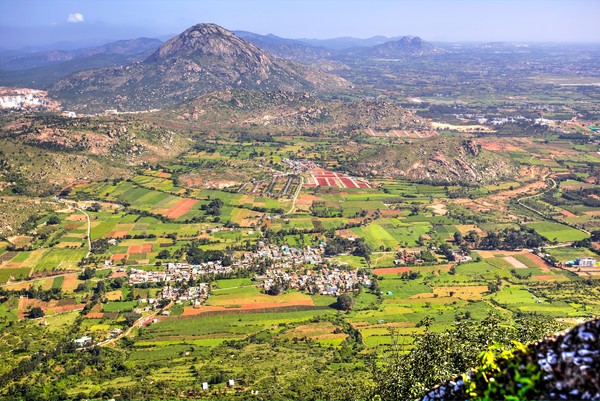
India continues to run
Also in 2024, the Subcontinent will register the highest GDP growth rate among the 'big ones' on the planet. Agriculture remains a strategic sector for the country-system but is affected by climate change and low productivity. The role of mechanisation in modernising the primary sector
End of January 2024. The World Economic Outlook comes out. And the International Monetary Fund analyses the health and prospects of the planet's major economies. World gross domestic product growth for both 2023 and 2024 is estimated to increase by 3.1%. The United States, after +2.5% in 2023, will grow by 2.1% in 2024. It is better for China, which, although declining compared to recent record years, will record +5.2% in 2023 and stop at around 4.5% in 2024. Europe is languishing, with Germany, the (former) locomotive of the 'old continent', negative (-0.3%) in the year just ended and with an estimated +0.5% for GDP 2024. France, for its part, is struggling to reach 1%, while Italy, which closed at +0.7% in 2023, is expected to remain at this level in 2024.
India's primacy. But who is at the top? The World Economic Outlook has no doubt: India. Which closed 2023 with a GDP growth of 6.7% in 2023 and is expected to move on the same wavelength (+6.5%) in 2024. More than a surprise, it is a confirmation if we consider that the country has had a Gross Domestic Product that has been growing steadily since 2014 (by an average of 7% per year) and has progressively surpassed the GDPs of Russia, Brazil, Canada, Italy, France and the United Kingdom, thus approaching those of Japan and Germany. Not only that. According to Goldman Sachs Research, India's GDP will surpass that of the Eurozone within 25 years (the estimate speaks of 2051) and that of the United States within fifty. Certainly the numbers are consequences of the fact that we are now facing the first country in the world in terms of population - at the beginning of 2023 it will overtake China - with almost 1.5 billion inhabitants over an area of more than 3.2 million square kilometres (nine and a half times Italy).
Agriculture, a strategic sector. So, it does not seem exaggerated to define the Indian subcontinent as the country of 'new' records. Including the less noble ones of inequality. According to Oxfam International, a very small part of the Indian population - just 1% - holds about 40% of the country's wealth, and if the figure is enlarged to include the wealthiest 5% of the population, it rises to 60%. While, conversely, half of the population with the lowest incomes holds just 3% of the total wealth. Against this backdrop, even if we are faced with significantly increasing rates of urbanisation, agriculture remains a strategic sector. A sector that still absorbs almost 60% of the population and produces around 17% of the country's GDP. The World Bank calls India 'one of the world's agricultural powerhouses', producing around 7.5% of the global agricultural commodities. A few numbers may make it clear how much this can affect the balance of the world's main commodities, even if the country's main objective remains to improve production for internal consumption, which has to face the aforementioned demographic explosion and, above all, get as many Indians as possible out of absolute poverty. Indeed, the same Oxfam analysis showed that between 60 and 70 per cent of the population has the equivalent of about two dollars a day.
The numbers of Indian agriculture. India is, by far, the world's largest producer of milk (almost 200 million tonnes out of a total of about 850 million; the United States - second - stops at about half), pulses (alone it occupies more than a quarter of the areas destined for them) and spices. But it is also the second largest producer of rice (around 150 million tonnes, after China's 200 million), wheat (over 100 million tonnes, not far from China's 140 million), cotton (practically on a par with its Chinese neighbours, with around 6 million tonnes a year) and sugar cane (just over 400 million tonnes, behind Brazil's over 700 million). But also fruit and vegetables (over 200 million tonnes after China's distant 700 million) and, on the livestock front, farmed fish, mutton and goat meat.
With an estimated agricultural gross value added of around USD 300 billion, India continues on its path of opening up to the world market, so much so that agricultural exports, after touching the USD 40 billion mark for the first time in 2021, are estimated to have exceeded USD 60 billion by the end of last year.
The problem of yields. Rather than absolute numbers, the Indian agricultural economy has to deal with the problem of yields. A significant example concerns rice: the latest available data indicate a productivity of just over 3 t/ha. Without moving to the high US values, which almost triple, neighbouring China stands at around 6 t/ha. These objectively low values have been and will continue to be affected by climate change and, in particular, by rising temperatures with the extreme heatwaves of recent years hitting hard. A recent joint study by the Universities of Cambridge and Yale shows that agriculture is among the socio-economic systems most exposed to climate change, which is hindering and reversing the progress made by the country on the sustainable development front. The negative impact, according to the research, manifests itself on the spread of diseases and grain yields. But also on the very essence of agriculture. In six years, between 2015 and 2021, India is estimated to have lost 33 million hectares of cultivated land due to floods and excessive rainfall, and as much as 35 million hectares due to drought. A phenomenon that seems destined to intensify. On the one hand, infrastructure problems with a very low average area (2 hectares), limited productivity, climate change. On the other hand, the need to increase agricultural performance and also the progressive, albeit slow and gradual, change and improvement of the food diet typical of developing and economically growing countries. How then to find an agricultural melting pot that can work?
The geography of production. After the slow start of the agrarian reform (three acts in the name of liberalisation, strongly opposed at least in the initial phase by farmers worried about the elimination of the guaranteed minimum price) the regions most involved in the primary sector (Haryana, Uttar Pradesh, Chattisgarh, Punjab) have resumed their slow but inexorable run. The case of Punjab is significant: 'the land of five rivers' is the breadbasket of India and is considered the most fertile area in the world due to the combination of the waters of the five rivers (Satluj, Bias, Ravi, Chenab and Jhelum) and the steppe climate. Although India is one of the smallest states, it alone produces 2% of the world's wheat, 1% of rice and 2% of cotton. Another case in point is that of Sikkim, a northern federal state that is the first 100% organic place. Sikkim is part of a specific plan, the Npop (National Programme for Organic Production), which plans to convert several hundred thousand hectares to organic farming, particularly in the Punjab and Chandigarh areas. These are therefore rapidly changing contexts in need of innovation and technical means, mechanisation above all. On the tractor front, the boom is well established with almost one million machines registered by 2023 (see article below), but demand for mechanisation is high in every segment. Consolidated by the fact that even recently the Modi government announced incentives for the modernisation of agricultural machinery and systems. These include the creation of hubs for high-tech agricultural equipment and the provision of financial assistance to farmers for the purchase of machinery, in order to stimulate the growth of the sector. This is clearly a significant opportunity for those who, like many Italian manufacturers, are able to provide state-of-the-art equipment and innovative solutions. The need is obvious. It must be intercepted in the best possible way.








